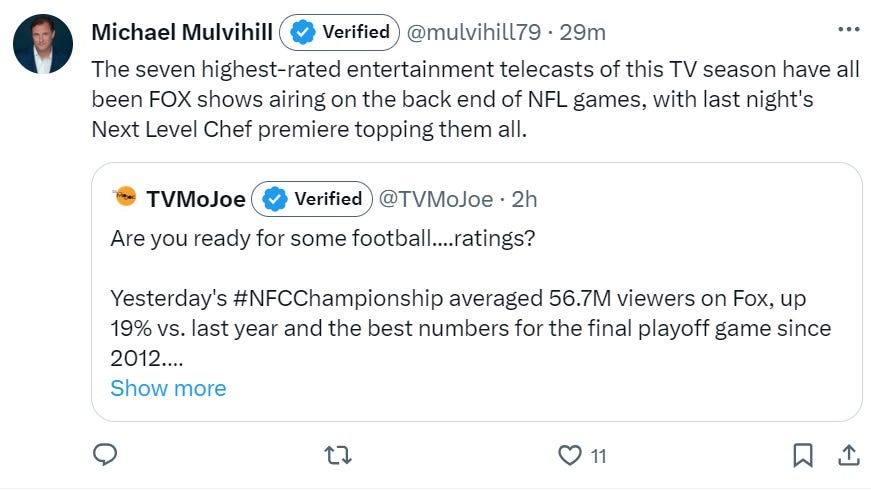Too Much TV: Your TV Talking Points For Monday, January 29th, 2024
In the land of dumb takes, the slightly less dumb take is king
Here's everything you need to know about the world of television for Monday, January 29th, 2024.
IN THE LAND OF DUMB TAKES, THE SLIGHTLY LESS DUMB TAKE IS KING
Advertising is coming to Amazon's Prime Video subscription service this week and while I'm not sure what impact that will end up having on Amazon's bottom line, it certainly has provided a gold rush in the category of dumb takes about the impact of the move on subscribers and the Prime Video business.
My personal favorite piece from today is from the Wall Street Journal, which manages to find a couple of subscribers unhappy with the prospect of being forced to watch commercials along with their episodes of Reacher:
Andrew Scott Grace says he is perfectly happy paying $15 a month to get free shipping for all his Amazon orders and have access to the Prime Video streaming service, which he watches frequently.
He draws the line at having to pay $3 more.
When Grace was notified last month that Prime Video would soon include commercials unless he paid extra, he immediately canceled his Prime subscription, forgoing the free-shipping perk and vowing to stop shopping from Amazon altogether.
“There is only one way to show them that this is not OK: to cancel,” said Grace, a 27-year-old gig worker from Sharon, Pa.
I don't doubt that a few people feel this way. But highlighting them in a story about the addition of advertising on Prime Video is more than slightly misleading.
And notice that I didn't describe the change as a "price increase,” even though that is the way I've seen it framed in 90% of the stories written today about the move. You can keep your subscription as is and it won't cost you one additional cent. You'll just have to watch a few commercials.
It's somewhat amazing to me how many customer's brains seem broken when it comes to watching advertising for a service that also charges a subscription fee:
Any amount of advertising is a no-no to many. “If I have to watch ads, I shouldn’t have to pay for my entertainment,” said Joel Gratcyk, a 42-year-old digital consultant from Chicago—a lesson he said he learned from all those years watching Netflix. He decided not to renew his Prime subscription when he found out about the new ad-supported Prime Video.
I don't mean to be unkind, but this is just idiotic. If you are 42-years-old, you've no doubt subscribed to cable or satellite television in the past, which is a business built on both advertising and a monthly subscription charge.
This change is happening for two reasons, neither one of which is receiving much attention in the press.
First, this move is a back-door way for Prime Video to increase its revenue. Simply raising the price for Amazon Prime would mean that the video product would only receive some small percentage of the money, given the many services that fall under the Prime umbrella and would also share in the increase.
Secondly, this reflects the reality that Prime Video would likely not be a very successful streaming service if it was a stand-alone product. Industry reporting frequently touts Amazon Prime's total subscriber number and extrapolates that in a way that makes Prime Video sound as if it has one of the largest SVOD subscriber bases in the world.
Amazon has never released any clear indication of how many Prime members actually regularly use Prime Video. But I was told by an Amazon executive on background a couple of years ago that the number of subscribers who regularly use Prime Video more than any other Amazon Prime membership benefit is typically in the "single digits." On the other side, the number of Amazon Prime subscribers who aren't regular Prime Video users (in this case, opening the app at least five times a month), is more than 50% of the total Amazon Prime subscriber base.
Assuming those numbers are in the ballpark of being correct, then Amazon's decision to include advertising inside its core Prime Video service is a no-brainer. Most current subscribers might not love the idea of a few ads. But if Amazon keeps the ad load low, it won't have much of an impact on the subscriber base. Most casual Prime Video users aren't going to drop Amazon Prime just because they find a few ads annoying. The move may convince them to watch Prime Video a bit less. But the overall ad revenue from everyone else should more than make up for the loss of a few malcontents.
And for that small number of hardcore Prime Video customers who decide to pay the $3 a month to watch without advertising, that fee is basically found money for Prime Video. It's money the service would be hard-pressed to get any other way and it helps shore up Prime Video's bottom line over the next several years.
So journalists...please do better.
TUESDAY VIEWING SUGGESTION
Although I can't officially post a review of Netflix's NASCAR: Full Speed until it goes live on the service in a few hours (insert rant about pointless embargoes), I will say the series is exactly what you would expect it to be. Huge NASCAR fans will no doubt love seeing some of the behind-the-scenes moments. But like Netflix's other sports series like Quarterback or Formula 1: Drive To Survive, this show is really made for the casual sports fan. It's sports-adjacent television and in the case of Full Speed, you'll find the series a lot more entertaining if you don't follow NASCAR closely enough to know who won last season's championship. BTW, here is a photo gallery of a few images from the series.
TWEET OF THE DAY
ODDS AND SODS
* Netflix co-founder Reed Hastings donated $1.1 billion worth of his stake in the streaming company to a California-based charity that is popular with technology founders because it gives them tax breaks and privacy:
Donor-advised funds have come under criticism because giving to them can generate an immediate tax deduction, while the donated funds can sit for years. By contrast, private foundations—another charitable vehicle often used by the wealthy—are required to distribute funds over time and must disclose details about donations and charitable operations.
* I haven't had much luck arranging an interview with Robert Mills, EVP, Unscripted & Alternative Entertainment at Walt Disney Television and to be honest, he's arguably the most successful programming executive on linear TV right now. So I was interested to read the coverage of his remarks at the Realscreen event in New Orleans in Deadline. Although in typical Deadline fashion, they took his comments and split them into multiple small articles, so they could use different headlines for each piece in order to juice the SEO for the posts. As Gordon Ramsay would say, "what a shame."
PERHAPS THIS MIGHT NOT BE THE BEST EXAMPLE OF A SUCCESSFUL BRAND EXTENSION
WHAT'S NEW TONIGHT AND THIS WEEKEND
MONDAY, JANUARY 29TH, 2024:
History's Greatest MysteriesSeason Premiere (History)
Love Island All-Stars UKSeries Premiere (Peacock)
Mighty Beheem’s Playtime(Netflix)
The Claremont Murders(Acorn TV)
The Greatest Night In Pop(Netflix)
The Irrational(NBC)
TUESDAY, JANUARY 30TH, 2024:
GerminalSeries Premiere (MHz Choice)
Jack Whitehall: Settle Down(Netflix)
NASCAR: Full Speed(Netflix) - [photo gallery]
Quantum LeapSeason 2B Premiere (NBC)
Professor TSeason Four Premiere (MHz Choice)
Vanderpump RulesSeason Premiere (Bravo)
SEE YOU TUESDAY!







Amazon Prime is an interesting case because almost no one is subscribing to it just to get Prime Video. I subscribed before Prime Video existed, and would continue to subscribe if Prime Video went away. In a sense, that makes Prime Video free.
I hate TV commercials and always DVR past them. If a service like Netflix forced commercials on me, I would cancel it. If Prime Video forced commercials on me, I would just stop watching Prime Video. I'm fine paying $3/month to not see the commercials. I watch something on Prime Video maybe twice a month on average.
I have to take issue with the suggestion that dropping Amazon Prime because of commercials is “just idiotic”. I think it is a rational response.
Unlike cable television, which as you note was built on an advertising/monthly subscription charge system, Amazon (and many of the other streaming services) explicitly made it a selling point that there were no commercials. They sold that as a benefit. That was why you should cut the cord, they said. Pay us a straight monthly fee and will give you content without annoying ads. To now tell people you have to pay extra for that is galling. The viewer shouldn't be blamed for being upset when the product they were sold is not the one they receive. It does have a bait and switch feel.
If Amazon can’t afford to spend billions on destroying IP properties such as the Lord of the Rings without forcing the less than 50% of people who stuck it through the entire first season to also watch ads for the Kevin James standup and or the latest Judge Judy show, then perhaps, as you intimate, Amazon should not be in the business.
Finally, you note, “Amazon has never released any clear indication of how many Prime members actually regularly use Prime Video,” but then go on to mention how overall ad revenue, aside from those you term ‘malcontents’, should more than make up for those who drop the service. But if there is no data to show how many people use the service, then no one, outside a few execs, knows what that number is. If Amazon claims to need the ad revenue to keep things afloat, every person who drops the service completely (or stops watching Prime), is another set of eyeballs not watching which will require additional ads to be shown in order to meet the target. The more ads shown will probably result in more ‘malcontents’ dropping the streaming service, requiring more ads to meet target levels, etc. That suggests Amazon is in danger of a death spiral.
(And I seriously doubt Amazon will keep the ad load low. If the Freevee model is any indication, it will make a lot of shows virtually unwatchable. Try to watch an early episode of an old show such as Columbo. There are ads every 5-7 minutes, completely destroying the flow).